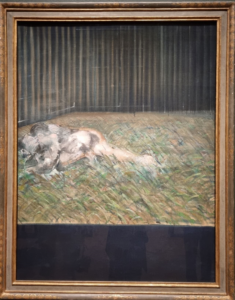
Francis Bacon, Two Figures, 1953
In 1953 and 1954, the painter Francis Bacon created two paintings of a pair of men closely entwined. Two Figures (1953) shows one nude man apparently pinning down another on the messy white sheets of a bed, in a dark space broken by white framing lines. In Two Figures in the Grass (1954), the men embrace and tangle their legs together on the grassy floor, surrounded by dark walls and more vertical lines. The spaces in both paintings feel oppressive and enclosed, with Bacon’s characteristic frames offering depth and perspective. To the modern eye—and indeed, to the eyes of Bacon’s contemporaries—both pairs are clearly lovers, locked in the throes of (perhaps violent) passion. Bacon was an out gay man in the fifties, over a decade before the 1967 Sexual Offences Act would decriminalise private homosexual sex acts in England—this being only a first step on the long road to ending the UK’s laws against gay sex (the last law against sodomy in Scotland was only repealed in 2009, with the repeal not coming into effect until 2013). Two Figures was painted at the house of Peter Lacy, Bacon’s partner of 10 years with whom he had a sadomasochistic, deeply loving, though at times tempestuous and violent relationship.
Bacon was known for drawing shapes and compositions for his paintings from a variety of reference material, mostly photographs and magazine clippings. Thousands of such images covered the floor of his studio in a mixture he called ‘compost’. The Two Figures paintings were no different, with the poses of the men taken from a series of photographs of wrestlers taken by Eadweard Muybridge (1830-1904), the pioneering photographer of animals and people in motion. These photographs show nude or nearly-nude men in various stages of combat; one series shows a pair of fighters collapsing to the floor in a series of poses closely reminiscent of Bacon’s figures.

Photographs of wrestlers by Eadweard Muybridge, c.1887
Bacon’s use of the wrestlers as reference material for his paintings of male lovers may have simply been an extension of his usual practice, or it may have been intended as a (albeit rather flimsy) defence against the potentially controversial subject matter of the paintings. In either case, in doing so Bacon became another entry in a history of artists using wrestling imagery to explore homoerotic themes that stretches back to Greek antiquity. The Greek term symplegma, meaning ‘entanglement’ and now most commonly used for artistic renderings of sexual intercourse, seems to have originally been used to describe sculptures of wrestlers. It is used in this way several times by Pliny the Elder during his lengthy discussion of marble sculpture in his Natural History, including one instance explicitly with the Latin term for wrestling:
…Pana et Olympum luctantes eodem loco Heliodorus, quod est alterum in terris symplegma nobile… [Pliny Natural History 36.4]
…in the same place the Pan and Olympus Wrestling, which is the second most famous grappling group in the world, was the work of Heliodorus… [tr. D. E. Eichholz]

The Wrestlers
The most famous surviving ancient sculpture of this type is usually known simply as The Wrestlers, a Roman marble based on a 3rd century BCE Greek original, possibly in bronze. It was discovered in 1583 and is now in the Uffizi in Florence. The sculpture depicts two nude men engaged in the sport of pankration, which combined elements of boxing and wrestling; one wrestler leans over the back of the other, holding his opponent’s arm behind him and wrapping his left leg around that of the lower wrestler. The sculpture depicts actual wrestling technique, but also offers an opportunity to display the two men’s athletic bodies in their prime, with muscles showing under the skin. This admiration of athletic nudity was a feature of both the sculpture and the sport: as Nick Fisher writes, ‘men believed that nakedness… should reveal the perfection of the trained body and that an erotic response to muscular, bronzed bodies gleaming with olive oil, like statues, was a natural part of the admiration elicited by divinely gifted beauty and skills’ (Fisher, 2014, p.250, my emphasis). Fisher’s comparison of the bodies of athletes to statues is apt here: both offered an opportunity to gaze at and celebrate beautiful male bodies in a socially acceptable, indeed appropriate, way.

Francis Bacon, Two Figures in the Grass, 1954
For Francis Bacon in 1950s England, any culture of admiration of athletic eroticised male bodies was necessarily hidden from public view, so Muybridge’s photographs both provided a crucial compositional reference and allowed Bacon to make his images of lovers visible, couched in more socially acceptable terms where necessitated by the criticisms of conservative viewers. Both Peter Lacy and Bacon’s other great love, George Dyer, would appear regularly in his paintings throughout his career, putting his sexuality at the heart of his artistic output. And while some of the original viewers of Two Figures and Two Figures in the Grass may have been scandalised when the paintings were first displayed, we may imagine that other appreciated them much as The Wrestlers and other symplegmata were appreciated in ancient Greece and Rome.
Francis Bacon: Man and Beast is showing at the Royal Academy of Arts until 17 April 2022.
References
Nick Fisher, 2014, ‘Athletics and Sexuality’ in Thomas K. Hubbard (ed.) A Companion to Greek and Roman Sexualities. Oxford: Blackwell. 248-268.
